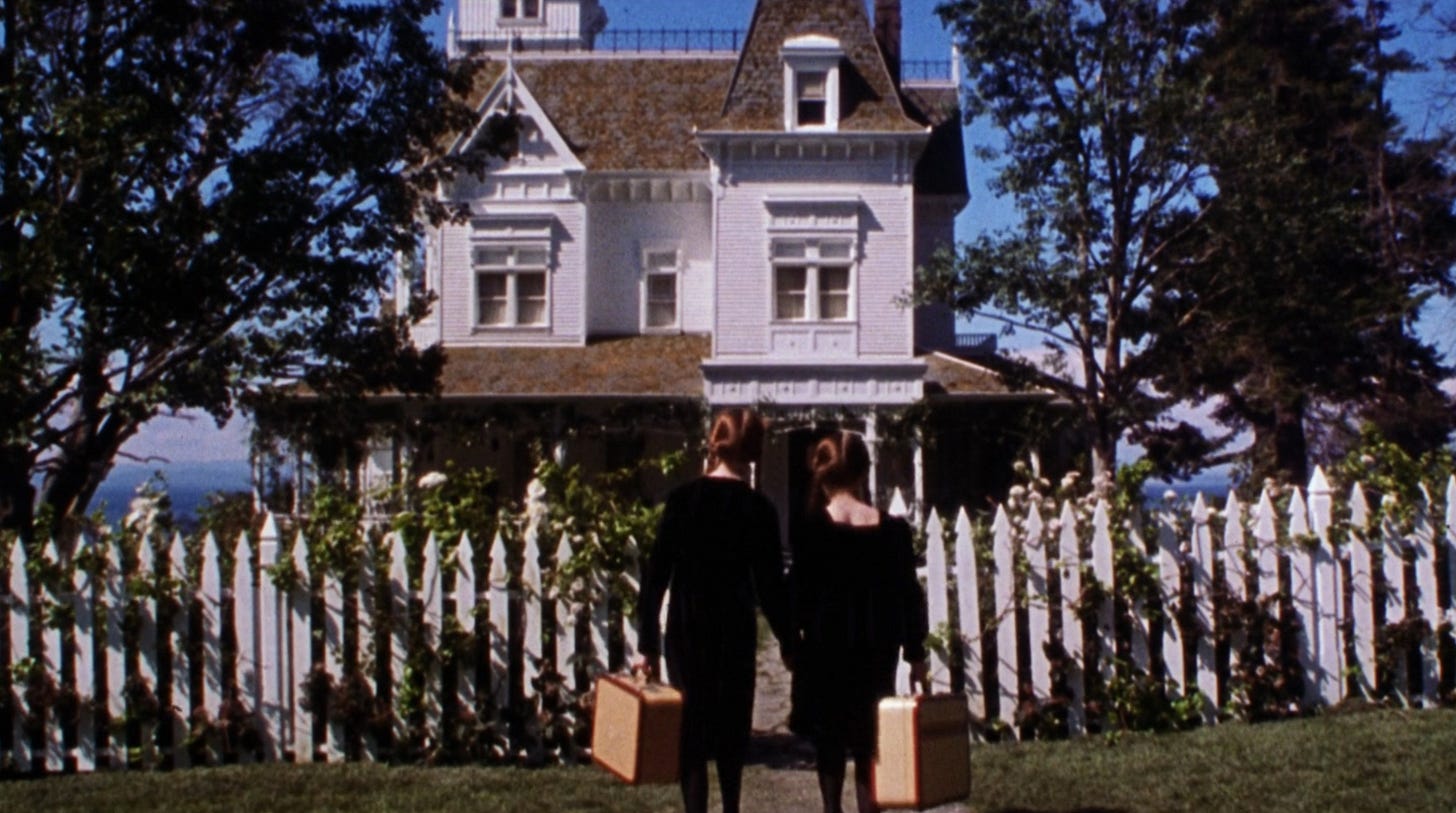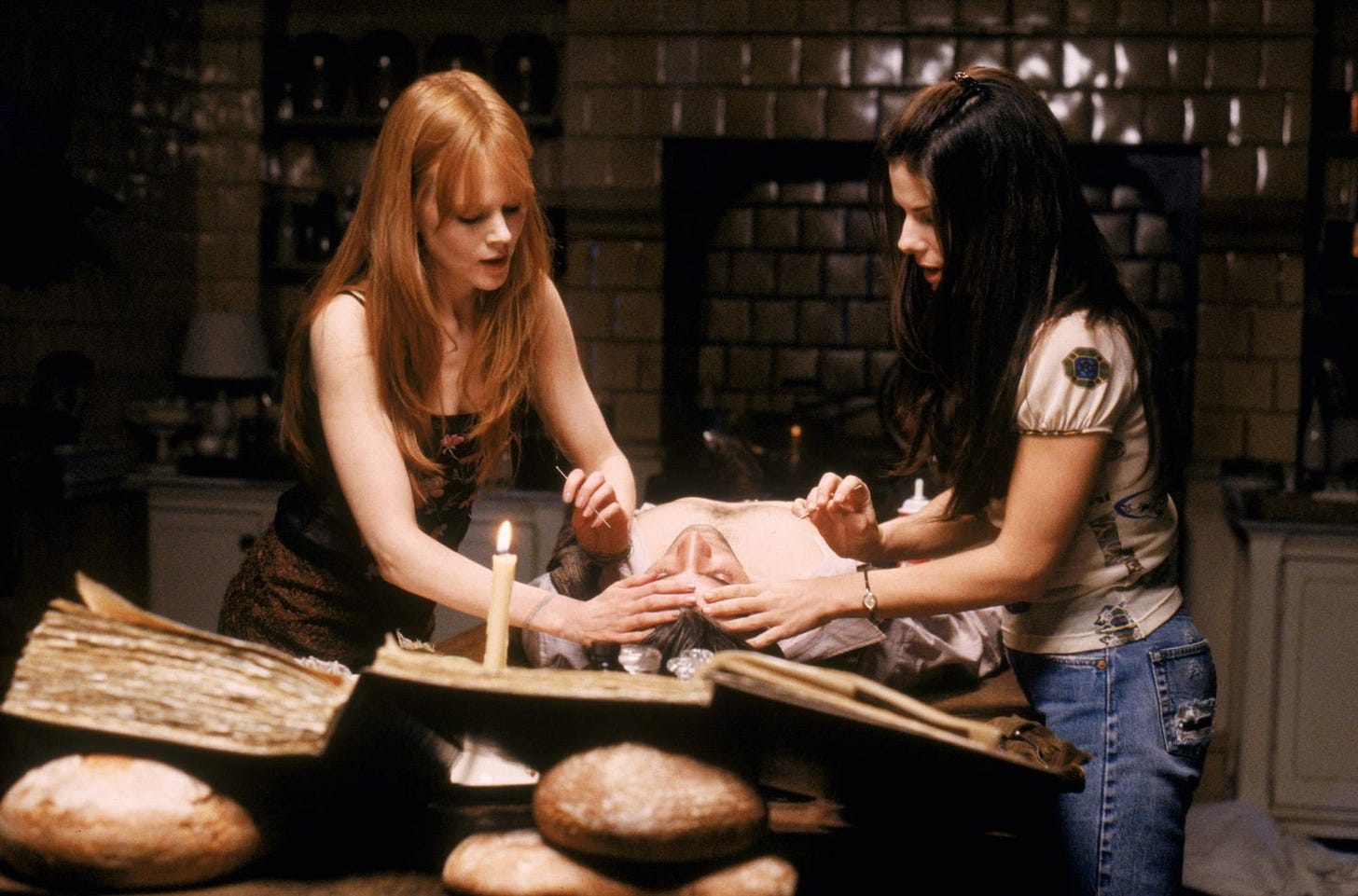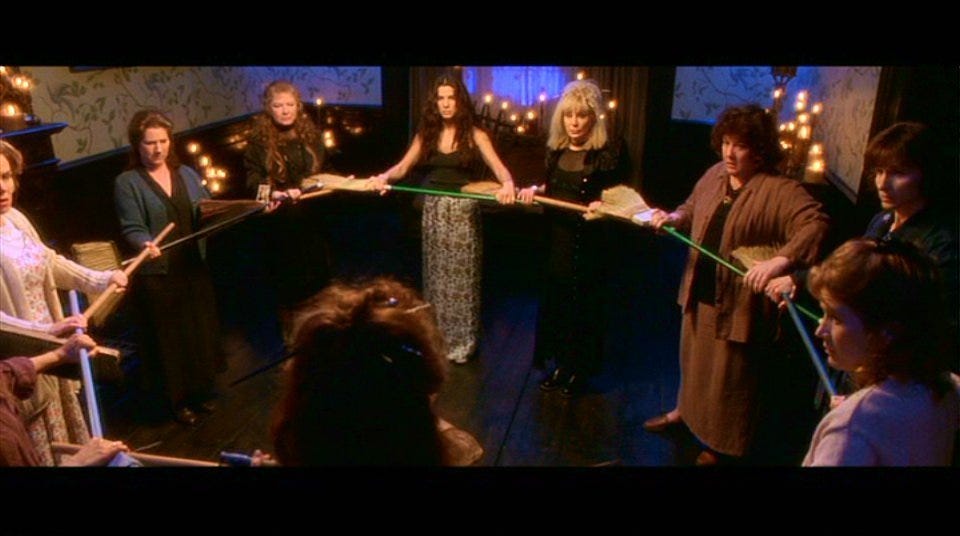Neurodivergent Gumbo 12
The House, the Hearth, and the Haunting: Practical Magic and the Price of Freedom
The House, the Hearth, and the Haunting: *Practical Magic* and the Price of Freedom
The House on the Cliff
Before the sisters, the curse, the resurrection, or the redemption, there was the house.
Perched high on a cliff above the sea, the Owens home looked like freedom wearing an apron—white clapboard, green shutters, herbs spilling from every window box.
It was the first time many of us saw women living in a world they built themselves, unbothered by husbands, priests, or landlords.
The air inside seemed different: softer, scented with salt and cinnamon, carrying laughter instead of apology.
It was chaos, clutter, and boundless joy.
Every corner hummed with contradiction—silk scarves draped over broom handles, teacups stacked beside spell books, jars of herbs sharing shelf space with liquor bottles.
The Owens house thrived on too much: too many colors, too many candles, too much life.
Where patriarchy sells order as virtue, these women made disorder sacred.
Their mess was proof of existence, of feeling, of staying alive through centuries that wanted them silent.
For women starved of permission, that kind of clutter felt like prayer.
The Aunts — Eccentricity as Autonomy
And presiding over this joyful disarray were Jet and Frances Owens—two women who made aging look like liberation.
They floated through the house in silk robes and sharp wit, equal parts perfume and rebellion.
They were the first elders I ever saw on screen who weren’t punished for being free.
No one demanded they shrink or explain; they simply were.
When the town whispered, they laughed louder.
When the world told them to dim, they lit another candle. But freedom, even when modeled for you, doesn’t always pass down clean. The next generation inherits both the magic and the warning: live boldly, but beware the cost.
The Aunts made chaos look easy; their nieces would learn what it took to survive it.
The Sisters — Survival and the Performance of Freedom
Sally and Gillian are supposed to be the modern heirs to the Owens legacy, but their magic comes wrapped in a warning label: love carefully, or die trying.
Sally hides behind competence—perfect garden, perfect kids, perfect grief. Gillian runs toward sensation, mistaking danger for devotion.
The movie calls it contrast; I call it conditioning.
When Jimmy Angelov’s violence finally erupts, the film pivots from romance to horror, and that’s where it wants us to bond—over domestic violence, over fear.
It’s a familiar Hollywood ritual: give women trauma, then hand them a broom and call it empowerment.
Even their reconciliation is framed as crisis management.
“It’s strange that the movie asks us to bond over a man’s violence,”
I keep thinking. “Our first act of sisterhood shouldn’t be cleaning up his mess. Survival isn’t communion; it’s triage.”
That’s why *Practical Magic* never really passes the Bechdel test.
Yes, the women talk to each other, but always about the orbit of men—their love, their loss, their ghosts.
Even magic itself is motivated by him: to resurrect, to banish, to forget.
The camera keeps circling back to male gravity as if it’s afraid of what female freedom would look like if it floated away.
And still, there’s something underneath that scripting—the glimpse of what could be.
When the women finally gather, when the exorcism turns into a town-wide ritual, you can feel another kind of story trying to surface: a version where women reach for each other before the world burns them, not after. That promise of sisterhood—of women reaching for one another—feels tender on screen, but it’s not an even reach.
Some of us are still standing just outside the circle, watching from the edge of the frame.
Edges of the Frame
There’s a classroom scene where Sally faces the gossip of other mothers, their whispers snapping through pastel blouses and PTA smiles.
It’s meant to show her alienation, the small-town judgment that follows every Owens woman.
But what I can’t unsee is the wide shot: the only two Black mothers placed at the far edges of the frame, silent, decorative.
The camera catches them just long enough to prove they exist, then forgets them.
That’s how Hollywood frames sisterhood — a circle with invisible borders.
It tells you “all women” while quietly meaning “the ones who look safe in daylight.”
Even in a movie about women’s liberation, Black presence is pushed to the periphery — there to complete the picture of community, not to participate in it.
“The camera’s democracy ends where its empathy does.”
Every time I see us at the edge of the image, I think about how the story started with us.
Before witchcraft was an aesthetic, it was survival.
Before cauldrons were cute, there were root workers, midwives, conjure women keeping whole communities alive with nothing but herbs, salt, and spirit.
Hollywood borrowed that lineage, drained it of blood, and called it *Practical Magic*.
And still, I understand the longing.
That classroom shot hurts because I want to be in it—not on the edges, but at the table.
The Owens women get to live out the fantasy of being fully themselves without dying for it.
Meanwhile, Black women’s magic has never been “practical”; it’s been criminal.
It’s the kind that gets renamed “voodoo” in the headlines and “attitude” in the office.
So when the movie preaches about women’s solidarity, I notice who gets to speak, who gets to be rescued, and who’s still invisible just outside the glow of the frame. But then, the movie tries to make it right.
The gossiping mouths turn into open hands; the town gathers; the brooms appear.
For a moment, the circle widens.
The Phone Tree — The Real Magic
When the phone tree lights up, it’s supposed to be the film’s turning point—the moment when isolation finally gives way to sisterhood.
The mothers who once whispered about the Owens women suddenly roll up their sleeves, grab their brooms, and show up to help banish a violent man’s ghost.
It’s filmed like a miracle: sunlight through dusty windows, laughter spilling into the attic, a coven reborn out of gossip and goodwill.
For a moment, it almost feels like the movie finally delivers on its promise—women choosing each other.
But I keep asking: Who gets a phone call like that in real life?
When Black women cry out for help, our phone trees don’t ring; our names trend.
We get headlines, hashtags, and silence.
Our stories get turned into cautionary tales, not communal healing.
The magic of that scene—the warmth, the laughter, the forgiveness—rests on a kind of safety most of us have never been granted.
White solidarity is shown as divine intervention; Black survival is still seen as disruption.
“In *Practical Magic*, womanhood is a candle circle. In the real world, some of us are still outside trying to find the door.”
And yet, I can’t help but feel something stirring as they sweep, chant, and grin through the dust.
There’s an ache inside that joy, a reminder that community can be medicine when it’s made of honesty.
For a heartbeat, the women are not defined by men, or curses, or perfection—they’re simply working in rhythm, hands to broom, grief to laughter.
That’s the kind of magic I believe in: the messy, collective kind.
The kind that shows up before someone gets hurt, not after. When the dust settles, the house is waiting—unchanged, eternal.
The story always leads us back there, to the place that holds what words and wounds can’t.
The House as Blueprint
By the end, we return to the house—the one constant in all that chaos, laughter, and loss.
Its windows are open again, candles flickering in the daylight, as if the walls themselves have exhaled.
It feels like victory, but what lingers for me is design.
Because the Owens house isn’t just architecture—it’s a blueprint for a life women were never meant to have.
Every inch of it defies obedience.
The kitchen overflows with glass jars and copper pots; herbs dry from the beams like prayer flags.
The dining table is always set for whoever needs to show up.
Nothing matches, and that’s the point.
It’s a home that bends with its occupants instead of disciplining them—a sensory sanctuary where noise is proof of life, not failure of order.
For anyone who’s been told they’re “too much,” it reads like a manifesto.
But that blueprint, like the film itself, is conditional.
The safety it offers depends on how you fit into the story.
White womanhood gets to make magic in public; everyone else is still accused of conjuring trouble.
The Owens home is a rebellion against patriarchy—but it’s also an inheritance of privilege.
Its freedom is staged, its security cinematic.
If a Black or brown woman built that same house on that same cliff, the neighbors would call it a coven before the paint dried.
“It’s easy to call something whimsical when the world has already decided your chaos is harmless.”
Still, I understand why people fall in love with it.
Because underneath the fantasy is a truth worth keeping: a house where emotion has room to spill, where grief and joy share the same kitchen, where difference isn’t something to hide.
It’s a promise we keep rewriting every time we build community, art, or kinship that doesn’t need permission. But even blueprints are illusions.
The coordinates of this story—like its safety—were never entirely real.
The Curse and the Continuation
Here’s the thing they don’t tell you in the credits: the movie wasn’t even filmed in New England.
All that clapboard charm, that mist rolling off the Atlantic—shot on the coast of Washington.
Even the coordinates of this story are pretend.
Sally says she’s headed to Logan, and yes, she means Logan Airport, but the road she’s on leads to a place that doesn’t really exist.
Maybe that’s why the house felt like a spell to me.
For someone who never had a childhood home—who slept on couches, in borrowed spaces, in the pause between other people’s stability—the Owens house was more than a backdrop.
It was proof that home could be made from willpower, that maybe belonging wasn’t something you inherited but something you built, messy and alive, with whoever stayed long enough to stir the pot.
It was the fantasy of permanence, of roots that didn’t come from suffering.
And maybe that’s what *Practical Magic* has always been selling: not witchcraft, but safety.
A myth of womanhood that says, “You can be wild as long as you’re wanted.”
The problem is, not everyone gets that invitation.
The house was filmed in Washington, but it was built on the illusion of New England safety—whiteness as stability, domesticity as sanctuary.
The real magic, the kind practiced by women like my grandmothers, aunties, and the girls who had to grow up too soon, doesn’t live on a cliff.
It lives in rented kitchens and borrowed rooms, in laughter too loud for the neighbors and tears you don’t have to hide.
“Hollywood built its New England on a Washington bluff.
I’ve been building my freedom on borrowed ground ever since.”
Still, I love this movie.
I love the aunts in their silk robes, the phone tree scene, the house that hums with too much *life*.
Because even if the fantasy isn’t built for me, it taught me something real:
You can build home from chaos, from clutter, from longing itself.
You can claim joy as your inheritance even when the deed was never in your name.
You can take the myth, drain it of its lies, and make it your own.
“Maybe that’s the most practical magic of all—turning what we were denied into somewhere we can finally rest.”
*Author’s note: I first saw Practical Magic as a girl without a home of her own. Decades later, I still watch it for the house—the myth of safety, the sound of women laughing, and the hope that one day, my chaos could be holy too.*
Images © 1998 Warner Bros. Pictures, used under fair use for the purposes of review and cultural commentary.






